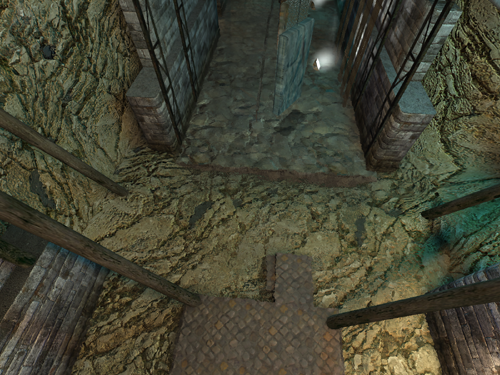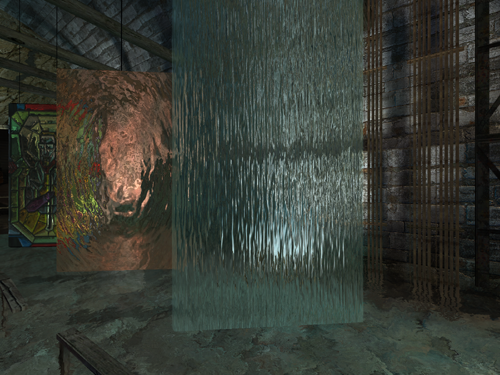Source Engine: Counterstrike Beta Hits The Street
by Derek Wilson on August 26, 2004 5:22 AM EST- Posted in
- GPUs
Source, CS, and Halflife 2
Before we take a look at the numbers, we have to know what we are dealing with. There are really three important components to address when looking at the beta version of Counterstrike: Source. First, there's the fact that the game is based on the Source engine and has a built in graphics stress test to push hardware to its limits and beyond. Next, there's Counterstrike and how that franchise fits into the equation. Finally, the crux of the matter, what do our observations reveal about the upcoming Halflife 2 title?
The opening of the Video Stress Test benchmark
In taking a look at the source engine test level supplied with CS:Source Beta, one of the first things we noticed was a difference in feeling between Source and id Software's latest engine. We've only got a test room and a sandy CS level to test the Source on, so we really haven't seen all that it has to offer, but our first impression of the engine is that it is very "clean". Clean like listening to an undistorted guitar after hearing some intensely heavy rock, or the feeling of looking at an HDTV next to an old UHF box. So far, the scenes we've seen rendered with Source show us that the engine is very good at producing crisp, clear images. Our initial impression of Doom III wasn't that it was any less real or vivid (we still got that warm, squishy, HD feeling inside), but that it was real in a dark, dirty, and atmospheric way. We will probably see how well Valve can coax their engine into producing similar situations at different points in Halflife 2, and surely there will be Doom III engine licensees who will create games with a slightly (for lack of a better word) happier feel. But at this point we don't have enough info to say that one engine is "better" than the other. So far, we'll just call them different. We are absolutely looking forward to seeing how Valve will integrate some of the very cool effects produced by the stress test in gaming situations.

Some of the more complex rendering that goes on in the Video Stress Test is overlapping reflective/refractive surfaces
Counterstrike: Source is somewhat of an interesting choice for Valve to lead off with. Historically, CS players have been very demanding on framerate. While we can't get 200fps at high resolutions, the subtle (and not so subtle) enhancements to the game engine add a depth to Counterstrike that could revitalize the franchise. Unlike the stress test, the enhancements in the one level available for play in Counterstrike: Source Beta (dust) aren't all about fire, water, reflection/refraction, and tv monitors. The main benefits we see in CS are in the added clarity, feeling of realism, and enhanced physics. Kicking a box or rolling an oil drum down a hill are fun enough to distract players from the game at hand. Actually, such real world interactions with the environment provide a new way to play: kicking a tire down one side of a hill to draw sniper fire, then running down the other is a very effective trick. Smoke and flashbang effects, muzzle flares, and explosions add to the experience as well. Lighting effects inside buildings pile on the realism. With the intensity of effects kept to a subtle level, high frame rates are still achievable, and if we decide to include CS: Source as a test game in future articles, we will put a larger emphasis on higher frame rates than we will from the stress test we will see benched here.
When it comes to Halflife 2, we still don't have a very good picture of how Counterstrike and the included stress test will relate to game play. We will very likely see less sheer graphical impact in the final version of HL2 than in the stress test. After all, Valve packed tons of water, translucent surfaces, and special effects into a tiny room in order to push graphics cards to the limit. We wouldn't expect (or want) to see a level like that in the game. Effects and eye candy are wonderful things, but game designers always need to be careful not to heap too much of a good thing on gamers. One of the most important aspects of the latest in the FPS genre is to put the player in the game as much as possible. At the same time, HL2 will have AI and huge levels with all kind of stuff going on. We really feel that HL2 will be much more CPU intensive than the graphics stress test (which we would hope), or even Counterstrike. Graphically, HL2 will likely be more intense than CS (as it will have more opportunity for strange alien special effects), though this remains to be seen.
So, with Halflife 2, we're looking at something more CPU intensive than both CS and the gpu stress test, and between the two in average graphical intensity. No, it's not easy to call. Especially since we haven't found a "good" way to benchmark our Counterstrike level yet. We take a brief look at CPU scaling with the video stress test on the A64FX platform, but this won't offer as much insight as we would like until we can get our hands on HL2. An in depth analysis of the impact of the cpu on the graphics engine as far removed from game play as possible could help us separate the graphics factor from the game benchmark later on if we decide to use HL2 as a CPU test (we are hoping to be able to test the impact of the new AI algorithm if possible).. Of course, that depends on the type of benchmarking software that comes with HL2 (if any).
But that's enough background. Now on to the tests.










50 Comments
View All Comments
DerekWilson - Friday, August 27, 2004 - link
we run with default configuration -- trilin opt on aniso opt off ... this probably accounts for the issues.there isn't a config that you can set to make nv and ati do the exact same thing. unfortunately. also, most people run default settings when it comes to opts (AFAIK).
Tobyus - Thursday, August 26, 2004 - link
Derek, I may have missed it in the article, but did you say whether or not you enabled Trilinear and Anistropic Optimizations? Also, I didn't see whether you ran with vsync off, but I am guessing you did since that causes about a 10 fps performance loss on my system.I ran the benchmarks with this system (yes, they are beta drivers, and I had Anistropic and Trilinear optimizations enabled, but I also ran the test with 61.77 drivers and at 1600x1200 with 4xAA, 8xAF and the Highest detail settings including Water: Reflect all, I was getting 52 fps)
Athlon 64 3000+
MSI K8T800
1GB OCZ PC3200
Geforce 6800 GT
Windows XP Pro SP1
DX9.0c
Forceware 65.62
My tests were all run with the highest settings in the advanced options, except reflect world/reflect all which I will specify in each individual benchmark. These tests were also run with 4xAA and 8xAF.
800x600
Reflect World: 126.88
Reflect All: 114.45
1024x768
Reflect World: 113.25
Reflect All: 102.98
1280x960
Reflect World: 88.95
Reflect All: 83.25
1600x1200
Reflect World: 55.61
Reflect All: 53.21
2048x1536
Reflect World: 31.30
Reflect All: 29.98
I don't understand why I had better performance than your system Derek. I have nothing overclocked, and the only settings I can think of that I have enabled that you may not have are the optimizations. Is it true that ATI cards default to running with optimizations and they cannot be disabled? If that is true, I would think that it would be fair to enable optimizations on the nvidia cards and that may show a nice improvement and a closer race between the two brands of cards.
SirDude - Thursday, August 26, 2004 - link
"As a student at North Carolina State University, Derek Wilson [B]double majored[/B] in both [B]Electrical and Computer Engineering[/B]. After graduating, Derek brought his extensive Engineering background to work with the AnandTech team. Derek's specializations include [B]compiler theory and design[/B], giving him [B]a unique understanding of microprocessor architecture and optimization[/B]. He has also done [B]extensive work[/B] in the [B]3D field[/B], having [B]designed and implemented[/B] his own [B]3D rendering engine[/B] as well as having done much [B]programming for modern console platforms[/B]. Derek's hands-on experience in the realm of 3D graphics gives him a unique eye in his coverage of the PC graphics industry."#35 you know better then this guy I suppose? Here's an idea for ya', why don't you shut up and go away you [B][U][I]Troll[/I][/U][/B]
thelanx - Thursday, August 26, 2004 - link
Just read the rest of the article, after reading between the typos and reading the conclusion, it appears even with the console commands, the FX series is still running the DX 8.0/8.1 path, even if you try to force the dx 9 path. Thus AT is justified in not including the fx 5950 in their review.#35, Looks like you could benefit from some homework too, perhaps reading that article you posted more carefully. ;) Next time, give constructive criticism but try not to be so harsh. You aren't the only one guilty of harshness, intellectual discussion and debate is great, but many of the discussions on the net would be better with more cool heads. :)
thelanx - Thursday, August 26, 2004 - link
#35 As I recall, and as the article you posted confirms, the 6800 series do not automatically run the benchmark in dx8, it is only the fx series and below.Ballistics - Thursday, August 26, 2004 - link
If you guys would have done your homework before posting this article you would have been informed. Having done that you could have accurstely informed us.Don't know a good way to benchmark CS Source? Don't know how to force the hardware to use DX 9.0 ? Don't mention that all nVidia cards are forced to use DX 8.1 while ATI trudges away at DX 9.0 and coincidentally falls behind?
Here's a link to the article: http://www.firingsquad.com/hardware/half_life_2_fx...
Educate yourselves.
yanon - Thursday, August 26, 2004 - link
In the future, Anandtech should do at least two benchmarks--one for the extreme gamer and one for the average gamer.Right now, the extreme gamers probably have AMD FX-53, the Raptor Drive, 2 Gbytes worth of elite super overclocked ram, and Geforce 6800GT/Ultra.
The average gamers probably have something close to AMD XP 2500+, any 7200rpm harddrive with 8Mbytes of cache, 512 MB to 1 GB worth of value DDR ram, Geforce 5700/ATI 96000/ ATI 9800.
yanon - Thursday, August 26, 2004 - link
The sentiment is clear. People want to see a benchmark score for a setup that includes AMD XP 2500+, ATI 9800 Pro, and 512 Mbytes of DDR 3200 ram.flashbacck - Thursday, August 26, 2004 - link
Can you guys post results for more midrange hardware? Not everyone has a Geforce 6800 XT, Radeon X800 SuperMegaUltraProPlatinumSpecialLimitedEdition or Athlon 64 50000+.Cygni - Thursday, August 26, 2004 - link
I like the way people are bitching about typos on a site thats offering FREE articles to the public. Jeeze.And oh, I dont really care what OTHER sites are getting on these tests. If you have been around the net, you know the likelyhood of Anandtech being wrong is pretty close to nil. This aint Toms.